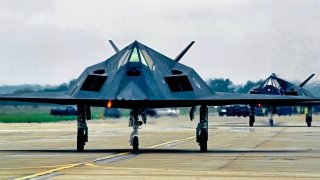The F-117 Stealth Fighter Made an Unofficial 'Stealth' Comeback
The Lockheed F-117 Nighthawk is one of the most visually distinct and historically significant aircraft in U.S. military history. Developed in secrecy during the Cold War, the F-117 was the first operational aircraft designed specifically for stealth, allowing it to penetrate sophisticated Soviet air defenses.
Summary and Key Points: The Lockheed F-117 Nighthawk is one of the most visually distinct and historically significant aircraft in U.S. military history. Developed in secrecy during the Cold War, the F-117 was the first operational aircraft designed specifically for stealth, allowing it to penetrate sophisticated Soviet air defenses.
-The angular, black jet was the product of intense research into low-radar-cross-section technology, which paved the way for modern stealth aircraft like the F-22, F-35, and B-21.
-The F-117's development was shrouded in secrecy, but its influence on stealth technology continues to shape the future of military aviation.
The F-117 Nighthawk: The Stealth Pioneer That Changed Air Combat
Of all the airframes the U.S. military has ever used, the Lockheed F-117 Nighthawk might be the most visually distinct. Developed in secret under various codenames, the F-117 is easy to spot with its highly angular features, a black finish, and a V-tail. The jet looks like a diamond or the tip of a spear – like something that might feature in a Batman film.
More important, the F-117 was a watershed project in the development of stealth technology, proof that the low-radar-cross-section concept was viable, and the seed of more advanced stealth features that are in use and under development today.
F-117: Developed in Secret
The decision to develop the F-117 was a result of American interactions with increasingly sophisticated Soviet surface-to-air missiles (SAMs) during the Vietnam War. As SAMs evolved and improved, American aircraft had a harder time surviving in contested air space, ultimately leading to the deduction that NATO forces would be unlikely to penetrate Soviet air space and conduct air strikes on targets in Eastern Europe – an unacceptable premise. T
The Americans initiated a program to develop an aircraft that could slip past Soviet air defenses and deliver ordnance on targets anywhere, regardless of air defenses. The goal was a stealth aircraft.
No one had operational stealth technology in the 1970s and 1980s, so the F-117 was a black project, kept under the strictest secrecy. The project began when DARPA issued Lockheed’s Skunk Works a contract to build two stealth fighters. Lockheed cobbled together two Stealth Strike Fighters to create a Frankenstein of existing airframes that made its debut flight in late 1977.

The program, known as Have Blue, was a success, prompting the Department of Defense to increase its funding for stealth technology. With a new budget, a new program, codenamed Senior Trend, began, for the purpose of developing a stealth fighter.
Senior Trend was developed secretly throughout the 1980s. The program was so secretive that when an F-117 prototype crashed in the Sequoia National Forest during the summer of 1986, the Air Force restricted the airspace around the crash site, established armed patrols, and replaced the F-117 debris with the stored remains of an F-101A Voodoo that had been stored at Area 51.
The F-117’s existence was finally confirmed in 1988, when Assistant Secretary of Defense J. Daniel Howard displayed a grainy photograph of the aircraft during a press conference. In 1990, two F-117s were revealed to the public at Nellis Air Force Base. The aircraft looked like nothing else in the Air Force inventory. They had faceted-angle surfaces with a black finish. The jet was designed singularly for stealth performance. The single-seat jet featured two non-afterburning General Electric F404 turbofan engines that had been heavily modified to have a cooler operational temperature and an obscured inlet and nozzle.
While the F-117 is retired today, the stealth research that went into the jet’s development has also been incorporated into active or upcoming stealth aircraft like the F-22, F-35, and B-21. In this way, the F-117 lives on.
About the Author: Harrison Kass
Harrison Kass is a defense and national security writer with over 1,000 total pieces on issues involving global affairs. An attorney, pilot, guitarist, and minor pro hockey player, Harrison joined the US Air Force as a Pilot Trainee but was medically discharged. Harrison holds a BA from Lake Forest College, a JD from the University of Oregon, and an MA from New York University. Harrison listens to Dokken.
Image Credit: Creative Commons and/or Shutterstock.


